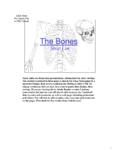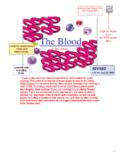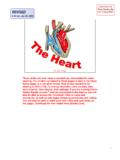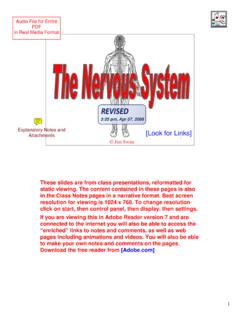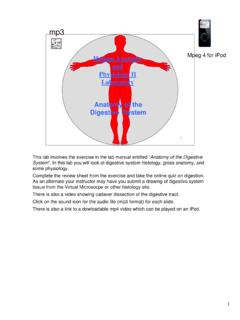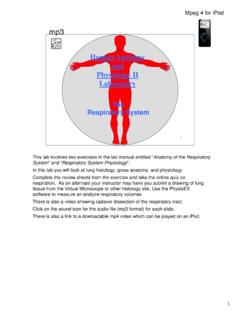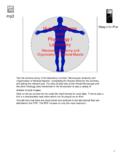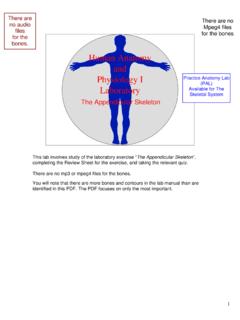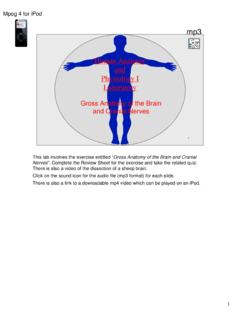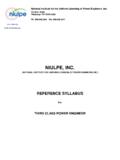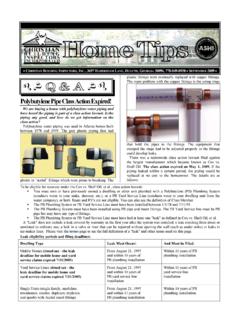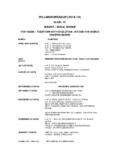Transcription of The Muscular System PDF - Class Videos for …
1 11:10 am, Feb 25, 2008 Entire PDF. Audio File In Real Media Format The Muscular System Jim Swan 1. These slides are from Class presentations, reformatted for static viewing. The content contained in these pages is also in the Class Notes pages in a narrative format. Best screen resolution for viewing is 1024 x 768. To change resolution click on start, then control panel, then display, then settings. If you are viewing this in Adobe Reader version 7 and are connected to the internet you will also be able to access the enriched links to notes and comments, as well as web pages including animations and Videos . You will also be able to make your own notes and comments on the pages. Download the free reader from [ ]. 1. 3 Types of Muscle Tissue Muscle Type Location Characteristics Control Attached to the Long, cynlindrical Skeletal cells; Voluntary bones for multinucleated, movement striated Short, branching cells, Involuntary Cardiac Muscle of the mononucleated, faintly Heart striated.
2 Forms myogenic functional syncytia. Smooth Single Unit: GI, Muscle Respiratory, & Small oblong cells, Involuntary Genitourinary tract mononucleated, myogenic mucous membranes. also may form a Multi-unit: smooth functional muscle in blood syncytium. 2. vessel walls. 2. Skeletal Muscle nuclei Connective endomysium separates cells. Striations =. dark bands Myofibrils fill sarcoplasm 3. The nuclei and other organelles of skeletal muscle cells are found next to the sarcolemms and the majority of the sarcoplasm is filled with the contractile machinery of the cell, the myofibrils. Skeletal muscle cells are derived from individual myocytes which fuse to produce a mature multinucleated muscle fiber. There are few if any of the precursor myocytes found in a mature muscle, and so muscles produce no new cells after maturity. Individual cells respond to training by enlarging and building myofibrils and other components. 3. Skeletal Muscle photomicrographs Dark striations = A-bands, the light areas between are the I-bands.
3 Z-line. From one Z. line to the next is a sarcomere. Z-line The sarcolemma is the cell membrane 4. 4. Cardiac Muscle Intercalated disks Faint striations Branching cells connect to form network. mononucleated The action potential travels through all cells connected together in a syncytium causing them to function as a unit. 5. Cardiac muscle cells are much shorter than cells in skeletal muscle and they branch to connect to neighboring cells through specialized membranes called intercalated disks to form a network called a syncytium. 5. Smooth Muscle nucleus Spindle -shaped mononucleated smooth muscle cell. 6. Smooth muscle cells connect to form single-unit syncytia similar to cardiac muscle. But impulses and contractions occur much more slowly in smooth than in cardiac muscle. 6. Smooth Muscle Arrangement In the intestine smooth muscle forms two distinct layers, one running along, the other running around the organ. Together these layers cause movements which propel the contents.
4 The circular layer runs around the intestine and its contraction causes segmentation The longitudinal layer runs along the 7. intestine; it causes wave-like contractions. 7. Types of Smooth Muscle Fibers Single unit smooth muscle cells connected to function as a single unit (syncytium). in GI tract Multiunit smooth muscle cells grouped into many contractile units controlled by the nervous System . in blood vessel walls and sphincters in GI tract. 8. 8. Structure of a Skeletal Muscle Tendon attachment Belly contains cells epimysium Fibrous covering perimysium fascicle { Surrounds fascicle Cell (fiber). endomysium Figure Surrounds cells (fibers). 9. The hierarchy of connective tissues associated with a skeletal muscle provide a continuous connection between muscle cells and their action on a bone or other attachment. At the same time cells are effectively separated from one another and each is controlled by a separate nerve fiber. 9. Functional Characteristics of Skeletal Muscle Excitability (responsiveness) muscles can be stimulated by electrical, chemical, and physical means.}
5 Contractility a muscle responds to stimuli by contracting. Elasticity muscles tend to recoil to their resting length. Extensibility muscles can be stretched beyond their resting length. 11. 11. Muscle Attachments Tendons attach muscle to bone. Aponeuroses broad, flat, tendinous attachment. Origin more fixed point of attachment. Insertion more movable point of attachment. Muscle action pulls insertion toward the origin. A muscle can only pull, it cannot push. 10. 10. Types of Muscle Contractions Agonist the prime mover; the muscle which performs the movement in question. Antagonist the muscle that performs the opposing movement to that of the agonist. Both muscles contract (exert tension) regardless of which is the agonist or antagonist. On-center movement that of the agonist Off-center (eccentric) movement that of the antagonist 12. The antagonist may actually be stretching while it is generating tension (contracting). 12. Knee Extension Agonist: the rectus femoris (quadriceps femoris).
6 Antagonist: the biceps femoris (hamstrings). 13. 13. Knee Flexion Agonist: the biceps femoris (hamstrings). Antagonist: the rectus femoris (quadriceps femoris). 14. 14. Synergists muscles which work together to perform a movement; often differs from the movement either performs when working alone. Fixators muscles which work to keep a part from moving; stabilizers, neutralizers. Assignment: make a list of 5 each antagonists, synergists, and fixators. 15. For each example you will need a couple of muscles: for antagonists you will need the two muscles which are antagonistic, for synergists the two or more muscles which work together, and for fixators the part of the body which is fixed and under what conditions. 15. A Muscle Cell nucleus = A Fiber myofibril striations sarcolemma {. I Band Striation = A Band Titin proteins A sarcomere actin myosin 16. Look at the video clip showing muscle hierarchy. From the largest to smallest the hierarchy is as follows: whole muscle is composed of bundles of cells called fasciculi, individual cells are composed of myofibrils, which are organized of myofilaments of actin and myosin and other proteins arranged in a specific way.}
7 16. The Sarcomere A-Band I-Band Z-disk H-zone Titin {. Actin filaments Myosin filaments (thin bands) (thick bands). 17. Titin proteins are part of the structural support for the myofilaments of the sarcomere and also a part of the series elastic elements along with other proteins and connective tissues. 17. Relaxed Click on the paper clip icons for The Z-disks do photo-micrographs not actually of the sarcomere at change. various degrees of contracted shortening. Note Partially how the I bands disappear and, as a result, the sarcomere darkens. contracted Fully 18. In the relaxed state you can see the resting-length overlap of actin and myosin fibers. Note how the actin myofilaments move together in the partially contracted muscle, and themselves overlap when fully contracted. As the muscle contracts the z-disk of the sarcomere move toward one another and the sarcomere shortens. The actin and myosin myofilaments themselves do not shorten, nor does the Z-disk, despite its appearance in this view which is an artifact from making the graphic.}
8 18. The Sliding Filament Mechanism of Muscle Contraction The shortening of sarcomeres, and the resulting muscle contraction, is due to the sliding of the actin and myosin myofilaments against one another. 19. 19. The Myosin Molecule Tail Heads Figure 20. Each myosin molecule is actually composed of two tails and two heads . 20. The Thick Filament 21. Myosin molecules are arranged into the thick filaments with their tails parallel and their heads projecting toward the adjacent actin filaments. 21. Thick and Thin Filaments in a Sarcomere Thin filament H zone Thick filament Connections Connections (crossbridge (crossbridge attachments). attachments) can can form form between between myosin heads and myosin heads and actin. actin. 22. Myosin heads project toward the acting filaments, with the heads angled toward the Z-disks on each side of the sarcomere. In the center of the thick myofilaments the H zone is bare of heads, with myosin tails only. 22. The Thin Filament Troponin complex Tropomyosin G Actin Tropomyosin blocks the crossbridge attachment sites on actin.
9 Troponin shifts to move tropomyosin and expose the active sites. 23. Tropomyosin molecules wrap around the fibrous actin myofilaments blocking the active sites where myosin heads could attach. Troponin complexes hold the tropomyosin in position, and when stimulated by the presence of Ca+2 ions the troponin complex moves, causing tropomyosin to shift and expose the active sites. 23. Cross-Section at Troponin Complex TnT = attaches to tropomyosin TnC = binds calcium ions TnI = shifts when Ca+2 binds tropomyosin Ca+2. 24. Figure 1) Ca+2 binds to TnC. 2) Troponin comlex shifts, moving tropomyosin, and exposing the active sites on actin. 3) Crossbridges attached from myosin heads to actin molecules. 24. Ca+2. Figure 25. 1) In response to Ca+2 release into the sarcoplasm, the troponin- tropomyosin complex removes its block from actin, and the myosin heads immediately bind to active sites. 2) The myosin heads then swivel, the Working Stroke, pulling the Z- lines closer together and shortening the sarcomeres.
10 As this occurs the products of ATP hydrolysis, ADP and Pi, are released. 3) ATP is taken up by the myosin heads as the crossbridges detach. If ATP is unavailable at this point the crossbridges cannot detach and release. Such a condition occurs in rigor mortis, the tensing seen in muscles after death, and in extreme forms of contracture in which muscle metabolism can no longer provide ATP. 4) ATP is hydrolyzed and the energy transferred to the myosin heads as they cock and reset for the next stimulus. 25. Neuromuscular Junction Flash Video The Neuromuscular Junction Chemically-gated Acetylcholine Sodium Channel Potassium AcHE. Channel Sodium- K+ Na+. Potasium Pump Calcium channel Ca++. Basal lamina Polarized sarcolemma +. - 15. Na+ is pumped out, K+ in at 3:2 producing unequal distribution which leads to a polarized membrane, ~ ) An impulse arrives at the neuromuscular junction causing Ca+2 to enter the axon terminus. 2) Ca+2 causes exocytosis of Ach vesicles into synaptic cleft.
